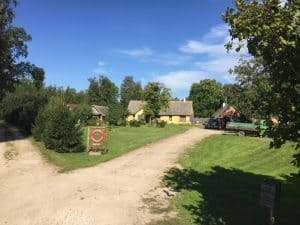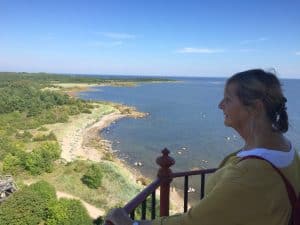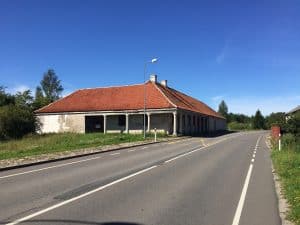We loved Riga but suffered the thump thump ‘music’ by the marina. It went on to 6:00AM on our day of departure, so we were very glad to get to sea, where we could take turns at getting some sleep.
We broke the long passage to Pärnu after 54nm at the small port of Kuiviži, which is re-inventing itself as a holiday location with chalets around the harbour. The next day was a further 40nm to Pärnu in a failing wind, which we achieved thanks again to the jenniker.
Pärnu lies at the mouth of the Pärnu river and we berthed at the Pärnu Yacht Club, which is an excellent club in a lovely setting with all facilities: lots of activity with youngsters out in small dinghies, the best ablution facilities to date and a restaurant open all day.
Pärnu dates back to 1251. In the 18c it was governed by Russia and became a popular summer resort for upper class Russians. Many lovely villas, mostly of wood, were build in parkland close to the beach and Empress Catherine II ordered the building of the Orthodox church and Empress Elizabeth funded the building of the St Elizabeth Church. In the 19c a bathing house and kursaal were established and later mud baths.
These days Pärnu styles itself the “summer capital of Estonia”. The wooded parkland close to the beach is delightful and still has lots of the old villas, many yet to be restored. The public buildings have been updated and some are luxury hotels. The town is also full of cafés and restaurants and has a very pleasant feel about it.
 On Thursday we set sail again, beating southwards into a strong breeze until we came to the small island of Kihnu. Like Ruhnu it was once inhabited by Swedes, but, being much closer to the Estonian mainland, the Estonian culture has been established much longer. It has developed its own dialect of Estonian and we heard it still being spoken – a distinctive sing-song intonation. The traditional costume is still worn by some, not just on special occasions or by those meeting tourists, for we saw a few older women going about their ordinary tasks wearing it. We spent time in the museum which showed old film recording the island traditions, including the complicated rituals around weddings, which were celebrated over three distinct days.
On Thursday we set sail again, beating southwards into a strong breeze until we came to the small island of Kihnu. Like Ruhnu it was once inhabited by Swedes, but, being much closer to the Estonian mainland, the Estonian culture has been established much longer. It has developed its own dialect of Estonian and we heard it still being spoken – a distinctive sing-song intonation. The traditional costume is still worn by some, not just on special occasions or by those meeting tourists, for we saw a few older women going about their ordinary tasks wearing it. We spent time in the museum which showed old film recording the island traditions, including the complicated rituals around weddings, which were celebrated over three distinct days.  We cycled the length of the island and climbed the lighthouse at the southern tip – a metal tower prefabricated in England, like several others in the region, and assembled in 1865. The keeper’s accommodation, built at that time, included a sauna, of course. Saunas are regarded as essential here and no modern fad. Every marina we have visited here has one as part of the harbour facilities.
We cycled the length of the island and climbed the lighthouse at the southern tip – a metal tower prefabricated in England, like several others in the region, and assembled in 1865. The keeper’s accommodation, built at that time, included a sauna, of course. Saunas are regarded as essential here and no modern fad. Every marina we have visited here has one as part of the harbour facilities.
The island had a lovely peaceful feel to it, much aided by glorious sunny weather.
On the Saturday we had a stiff sail in F6, with a few gusts to F7, around the southern end of Kihnu and up to Kuivastu on the island of Muhu, formerly known as Moon.
Arthur Ransome called at Kuivastu in Racundra in 1922. Then there was no harbour – just an anchorage and jetty. The ferry to the mainland was an old cutter which had to wait for the right wind to make the crossing. Ransom described the women of Moon, in their orange petticoats and black tops, driving their cattle onto the cutter to take them to market on the mainland. To return to Moon they had to shelter in the woods until the cutter had the right wind for the crossing – no terminal buildings in those days!  We also saw the old Russian inn visited by Ransome, then still with its great beds once sleeping a dozen to twenty. “The innkeeper told me he once had some beer but there was none left. Once upon a time he had some kvas. Now nothing[…]”
We also saw the old Russian inn visited by Ransome, then still with its great beds once sleeping a dozen to twenty. “The innkeeper told me he once had some beer but there was none left. Once upon a time he had some kvas. Now nothing[…]”
Today there is a splendid yacht harbour and cattle trucks roll onto the ferries that run almost constantly as this is the route from the mainland not just to Muhu but via a causeway to the large island of Saaremaa. There is a modern fast road along which an almost constant stream of vehicles speed past the now derelict inn. We explored some of Muhu on our cycles. Away from the busy road there are some delightful byways with old farms and homesteads nestling in the woods. But, to us, there was not the deep peace we felt on the more isolated islands of Ruhnu and Kihnu.
We visited the ruins of the ancient stronghold where the Estonians made their last stand against the ‘Christianising’ northern crusaders in 1227. It is said that 2,500 Estonians faced 20,000 of the Teutonic Knights’ men. Legend has it that just one escaped alive. The terrors and cruelty of Isis are nothing new.
We stayed on Muhu for five nights waiting for the best wind for the next passage and had two convivial evenings with Ted and Kay – a rare encounter with other British sailors. Today we left Muhu passing north through the rock-strewn Moon Sound between Muhu, the mainland and other islands. This passage was negotiated by Ransome back in 1922 and we followed the same leading marks and towers he described. These days there are more buoys and GPS makes the whole thing much easier and safer.
We came finally to the new port at Kärdla on the island of Hiiumaa, where we will be laying up for the winter. It has been a particularly fascinating cruise this year, visiting fifty two ports in eight countries, as well as many anchorages. You can see our recorded track here.
We will round the year off once we are all tucked up. Until then…
Ynskje & Tony




